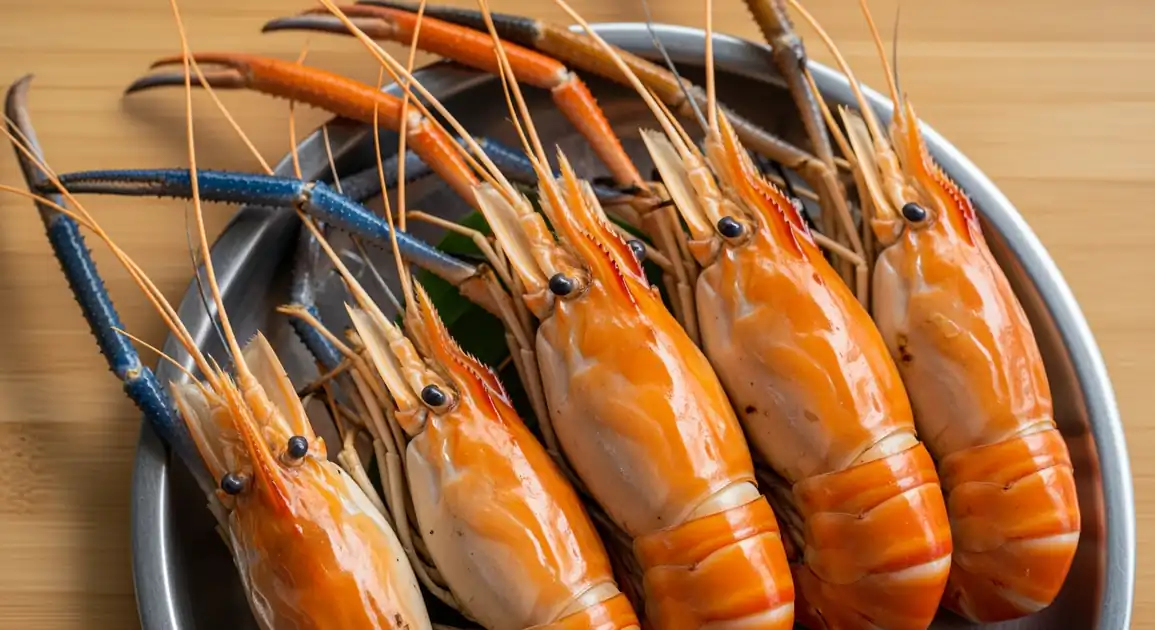Grilled Giant River Prawn
กุ้งแม่น้ำเผา (Goong Mae Nam Pao)

Description
Grilled Giant River Prawns ('Goong Pao') are a celebrated dish throughout Thailand, particularly esteemed in central regions along major rivers like the Chao Phraya. Availability is generally year-round due to both wild catch and extensive aquaculture. It's considered a premium seafood experience, often enjoyed at riverside restaurants or specialized seafood markets.
Dietary Information
Serving information
Serving style
Served hot directly from the charcoal grill, usually split lengthwise or whole. Accompanied by a small bowl of spicy, sour 'nam jim seafood' dipping sauce. Steamed jasmine rice is typically ordered alongside.
Quick facts
Restaurants typically open for Lunch (approx. 11 AM - 3 PM) and Dinner (approx. 5 PM - 10 PM). Market stalls operate during daytime market hours.
Safety Tips
What to Look For
-
Prawns cooked fresh to order over visible charcoal grill
Ensures prawns are cooked thoroughly from raw, minimizing risks associated with pre-cooked or improperly heated food. High heat grilling is essential for safety, especially with freshwater shellfish.
-
Bright orange/red shells and opaque, firm white flesh
Clear visual indicators of proper cooking. Avoid any prawns with greyish, translucent patches, which signal undercooking and potential risk.
-
Restaurant/stall displays fresh prawns (lively in tanks or bright/firm on ice)
Good sign of quality sourcing. Prawns should look plump, have vibrant (raw) color, and smell fresh (mild, not fishy or ammonia-like).
-
Served piping hot directly from the grill
Indicates freshness and reduces the window for bacterial contamination after cooking.
-
Clean grilling area; vendor uses separate utensils for raw and cooked food
Essential to prevent cross-contamination between raw shellfish and cooked, ready-to-eat prawns.
What to avoid
-
Pre-cooked prawns sitting in a display, possibly reheated
High risk of bacterial growth at room temperature. Always insist on prawns grilled fresh ('pao mai').
-
Prawns that smell strongly fishy, ammoniated, or 'off'
Clear indicator of spoilage. Fresh river prawns should have a relatively neutral or slightly sweet smell.
-
Prawns with dull shells, significant black spots (melanosis), or mushy texture
Signs of poor quality, lack of freshness, or improper handling.
-
Visibly undercooked prawns (translucent or greyish flesh)
Can harbor harmful bacteria or parasites sometimes found in freshwater environments. Do not eat if undercooked.
-
Places with generally poor hygiene standards (dirty surfaces, flies, unclean vendor)
Increases the overall risk of contamination.
Price information
Price range
Budget tips
- Prices are almost always based on weight (per kilogram) or by prawn size.
- Confirm the price *before* ordering to avoid surprises.
- Market restaurants (especially outside major tourist hubs) tend to be cheaper than upscale riverside venues.
- Smaller prawns offer the same flavor at a lower cost.
Value indicators
- Freshness (lively in tank or bright/firm on ice).
- Size and plumpness relative to the price.
- Richly colored orange head fat ('man goong').
- Authentic charcoal grilling aroma.
- Quality and taste of the accompanying 'nam jim seafood'.
Where to Find This Dish
Riverside Areas (Major Rivers)
Restaurants situated directly on riverbanks (Chao Phraya, Pasak, Bang Pakong) often specialize in river prawns.
Chao Phraya River, Pasak River
Lunch (11 AM - 3 PM), Dinner (5 PM - 10 PM)
Seafood Markets with Cooking Services
Markets where you can buy fresh prawns and have them cooked at adjacent stalls/restaurants.
Mahachai Market (Samut Sakhon), Ayutthaya Central Market, Some Bangkok markets (e.g., Or Tor Kor)
Daytime (Market Hours)
Specialized Goong Pao Restaurants
Stand-alone restaurants known specifically for high-quality Goong Pao, often popular with locals.
Varies - requires local research
Lunch, Dinner
Vendor Tips
- Compare prices per kilogram or per size class between different vendors.
- Always confirm the final price before agreeing to the purchase/cooking.
- If possible, choose your own prawns from the display or live tank to ensure freshness.
- Specify how well-cooked you prefer, asking for 'sook sook' (well-cooked) is safer.
How to Order
Regional Variations
-
Goong Ob Woon Sen
(กุ้งอบวุ้นเส้น)
A popular alternative preparation where large prawns are baked/steamed in a clay pot with glass noodles (woon sen), ginger, garlic, cilantro roots, soy sauce, and typically pork belly or lard for richness.
-
Tom Yum Goong (Mae Nam)
(ต้มยำกุ้ง (แม่น้ำ))
Thailand's famous hot and sour soup made with giant river prawns instead of the more common sea prawns. The 'man goong' adds extra richness and depth to the broth.
-
Choo Chee Goong Mae Nam
(ฉู่ฉี่กุ้งแม่น้ำ)
Giant river prawns cooked in a thick, rich, and creamy red curry sauce ('choo chee' curry) flavored heavily with coconut milk and kaffir lime leaves.
-
Steamed Giant River Prawns
(กุ้งแม่น้ำนึ่ง (Goong Mae Nam Neung))
Prawns are steamed plain or with simple aromatics like garlic or lemongrass, highlighting their natural sweetness. Served with 'nam jim seafood'.
-
Prawn Sizes
(ขนาดกุ้ง (Kanat Goong))
Not a different dish, but prawns are sold in various sizes, significantly impacting price. Smaller ones are more affordable, while jumbo sizes are a luxury.
Cultural context
History
Giant river prawns have been a valuable food source from Thailand's central plains rivers for centuries. Ayutthaya, the magnificent former capital situated strategically on the riverbanks, became particularly renowned for this bounty. The traditional method of charcoal grilling ('pao') enhances the prawn's natural sweetness and imparts a desirable smoky aroma. Historically a food for royalty and special occasions, Goong Pao remains a highly-regarded dish, symbolizing abundance and Thai culinary heritage.
Local significance
A symbol of Thailand's natural abundance, particularly riverine resources. Considered a prestigious dish often served to guests or during celebrations. The head fat ('man goong') is especially prized and central to the experience.
Eating customs
- Mixing the 'man goong' with hot steamed rice before eating.
- Using hands to peel the prawn shell is common and accepted.
- Generously dipping the meat into the 'nam jim seafood' sauce.
- Sharing large prawns amongst the dining party.